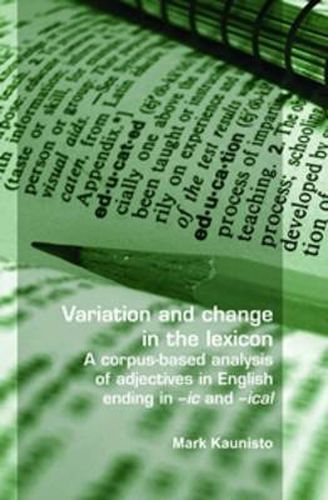Readings Newsletter
Become a Readings Member to make your shopping experience even easier.
Sign in or sign up for free!
You’re not far away from qualifying for FREE standard shipping within Australia
You’ve qualified for FREE standard shipping within Australia
The cart is loading…






The present volume is a corpus-based study of the occurrence, variation, and change in the use of English adjective pairs in -ic and -ical over several centuries. The study involves the analysis of large, multi-million-word corpora representing the English language at various stages. It examines the nature of competition between the two affixes: what kind of rivalry existed, what kinds of words entered into competition, and in what ways the rivalry was resolved. The book presents close studies of six notably differentiated -ic/-ical adjective pairs, namely classic/classical, comic/comical, economic/economical, electric/electrical, historic/historical, and magic/magical, as well as commentaries on some 40 other -ic/-ical pairs, which manifest different types of shifts in use through history. It also includes critical discussion of general perceptions on and approaches to the practical use of corpora, stressing the importance of close and careful study of the materials under analysis. It further emphasises the value of consulting a variety of sources alongside corpora, including dictionaries and language usage manuals. This volume is of interest to language scholars in many fields, including corpus linguistics, diachronic linguistics, semantic change, lexicology, and word formation.
$9.00 standard shipping within Australia
FREE standard shipping within Australia for orders over $100.00
Express & International shipping calculated at checkout
The present volume is a corpus-based study of the occurrence, variation, and change in the use of English adjective pairs in -ic and -ical over several centuries. The study involves the analysis of large, multi-million-word corpora representing the English language at various stages. It examines the nature of competition between the two affixes: what kind of rivalry existed, what kinds of words entered into competition, and in what ways the rivalry was resolved. The book presents close studies of six notably differentiated -ic/-ical adjective pairs, namely classic/classical, comic/comical, economic/economical, electric/electrical, historic/historical, and magic/magical, as well as commentaries on some 40 other -ic/-ical pairs, which manifest different types of shifts in use through history. It also includes critical discussion of general perceptions on and approaches to the practical use of corpora, stressing the importance of close and careful study of the materials under analysis. It further emphasises the value of consulting a variety of sources alongside corpora, including dictionaries and language usage manuals. This volume is of interest to language scholars in many fields, including corpus linguistics, diachronic linguistics, semantic change, lexicology, and word formation.